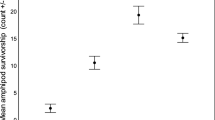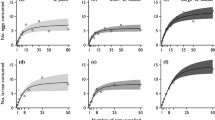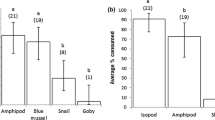Abstract
Despite the fact that native species of amphipods have been recognized as active predators similarly to invasive species, little is known about their predatory impact on aquatic communities. In this study, we used a laboratory experiment, a field enclosure experiment, and an analysis of natural community data to demonstrate how Gammarus fossarum affects the species composition of benthic communities by imposing survival selection on its prey. Our laboratory single-prey experiment brought a clear evidence that tube-less chironomids are vulnerable prey and that the predation rate on the tube-dwelling chironomids decreases with increasing tube toughness (from the soft tubes made of detritus to the hard tubes made of sand or calcium carbonate grains). We found that the introduction of G. fossarum to field enclosures significantly changed the species composition of a macroinvertebrate community at an experimental spring fen site. The soft-bodied, slow moving, and tube-less taxa were depleted the most. It appears that the observed patterns were a result of predator’s preference rather than encounter rate. Survival selection was detected also in natural communities across a large spatial scale. In accordance with the experiments, high densities of G. fossarum limited the proportion or abundance of vulnerable prey. Our study (1) provides the first convincing evidence that biotic interactions have a structuring effect on the spring fen communities, (2) documents how the predatory effect in a community depends on an interplay between the prey handling behaviour of the predator and species-specific susceptibility of prey, and (3) shows that an omnivorous native amphipod may have a strong impact on aquatic communities despite it is regarded less aggressive than its invasive relatives.






Similar content being viewed by others
References
Bacela-Spychalska K, van der Velde G (2013) There is more than one „killer shrimp“: trophic positions and predatory abilities of invasive amphipods of Ponto-Caspian origin. Freshw Biol 58:730–741
Bovy HC, Barrios-O’Neill D, Emmerson MC, Aldridge DC, Dick JTA (2015) Predicting the predatory impact of the “demon shrimp” Dikerogammarus haemobaphes, on native and previously introduced species. Biol Invasions 17:597–607
Cooper SD, Walde SJ, Peckarsky BL (1990) Prey exchange rates and the impact of predators on prey populations in streams. Ecology 71:1503–1514
Dangles O, Guérold FA (2000) Feeding activity of Gammarus fossarum (Crustacea: Amphipoda) in acidic and low mineralized stress. Verhandlungen des Internationalen Verein Limnologie 27:1–4
De Gelder S, van der Velde G, Platvoet D, Leung N, Dorenbosch M, Hendriks HWM, Leuven RSEW (2016) Competition for shelter sites: testing a possible mechanism for gammarid species displacements. Basic Appl Ecol 17:455–462
Dick JTA (1995) The cannibalistic behaviour of two Gammarus species (Crustacea: Amphipoda). J Zool 236:697–706
Dick JTA, Platvoet D, Kelly DW (2002) Predatory impact of the freshwater invader Dikerogammarus villosus (Crustacea: Amphipoda). Can J Fish Aquat Sci 59:1078–1084
Dillon PM (1985) Chironomid larval size and case presence influence capture success achieved by dragonfly larvae. Freshw Invertebr Biol 4:22–29
Dodd JA, Dick JTA, Alexander ME, MacNeil C, Dunn AM, Aldridge DC (2014) Predicting the ecological impacts of a new freshwater invader: functional responses and prey selectivity of the “killer shrimp”, Dikerogammarus villosus, compared to the native Gammarus pulex. Freshw Biol 59:337–352
Felten V, Tixier G, Guérold F, Crespin De Billy V, Dangles O (2008) Quantification of diet variability in a stream amphipod: Implications for ecosystem functioning. Fundam Appl Limnol 170:303–313
Glazier DS (1991) The fauna of North American temperate cold springs: patterns and hypotheses. Freshw Biol 26:527–542
Hájek M, Horsák M, Hájková P, Dítě D (2006) Habitat diversity of central European fens in relation to environmental gradients and an effort to standardise fen terminology in ecological studies. Perspect Plant Ecol Evol Syst 8:97–114
Hellmann C, Wissel B, Winkelmann C (2013) Omnivores as seasonally important predators in a stream food web. J North Am Benthol Soc 32:548–562
Hershey AE (1987) Tubes and foraging behavior in larval Chironomidae: implications for predator avoidance. Oecologia 73:236–241
Hershey AE, Dodson SI (1985) Selective predation by a sculpin and a stonefly on two chironomids in laboratory feeding trials. Hydrobiologia 124:269–273
Horsák M, Polášková V, Zhai M, Bojková J, Syrovátka V, Šorfová V, Schenková J, Polášek M, Peterka T, Hájek M (2018) Spring-fen habitat islands in a warming climate: partitioning the effects of mesoclimate air and water temperature on aquatic and terrestrial biota. Sci Total Environ 634:355–365
Hothorn T, Bretz F, Westfall P, Heiberger RM (2018) multcomp: simultaneous inference in general parametric models. R package Version 1.0-0. URL http://CRAN.R-project.org/package=multcomp
Kalčíková G, Englert D, Rosenfeldt RR, Seitz F, Schulz R, Bundschuh M (2014) Combined effect of UV-irradiation and TiO2-nanoparticles on the predator-prey interaction of gammarids and mayfly nymphs. Environ Pollut 186:136–140
Kelly DW, Dick JTA, Montgomery WI (2002a) Predation on mayfly nymph, Baetis rhodani, by native and introduced Gammarus: diet effects and the facilitation of predation by salmonids. Freshw Biol 47:1257–1268
Kelly DW, Dick JTA, Montgomery WI (2002b) The functional role of Gammarus (Crustacea, Amphipoda): shredders, predators, or both? Hydrobiologia 485:199–203
Klečka J, Boukal DS (2014) The effect of habitat structure on prey mortality depends on predator and prey microhabitat use. Oecologia 176:183–191
Krisp H, Maier G (2005) Consumption of macroinvertebrates by invasive and native gammarids: a comparison. J Limnol 64:55–59
Lancaster J, Bradley D, Hogan A, Waldron S (2005) Intraguild omnivory in predatory stream insects. J Anim Ecol 74:619–629
MacNeil C, Dick JTA, Elwood RW (1997) The trophic ecology of freshwater Gammarus spp. (Crustacea: Amphipoda): problems and perspectives concerning the functional feeding group concept. Biol Rev 72:349–364
Maier G, Kley A, Schank Y, Maier M, Mayer G, Waloszek D (2011) Density and temperature dependent feeding rates in an established and an alien freshwater gammarid fed on chironomid larvae. J Limnol 70:123–128
Meijering MPD (1972) Physiologische beiträge zur Frage der Systematischen Stellung von Gammarus pulex (L.) und Gammarus fossarum Koch (Amphipoda). Crustaceana Suppl(3):313–325
Nielsen A (1951) Contributions to the metamorphosis and biology of the genus Atrichopogon Kieffer (Diptera, Ceratopogonidae) with remarks on the evolution and taxonomy of the genus. Biologiske Skrifter 6:1–95
Oksanen J, Blanchet FG, Friendly M, Kindt R, Legendre P, McGlinn D, Minchin PR, O’Hara RB, Simpson GL, Solymos P, Stevens MHH, Szoecs E, Wagner H (2018) Vegan: community ecology package. 2013. R-package Version 2.4–2. http://CRAN.R-project.org/package=vegan
Omelková M, Syrovátka V, Křoupalová V, Rádková V, Bojková J, Horsák M, Zhai M, Helešic J (2013) Dipteran assemblages of spring fens closely follow the gradient of groundwater mineral richness. Can J Fish Aquat Sci 70:689–700
Otto C (1974) Growth and energetics in a larval population of Potamophylax cingulatus (Steph.) (Trichoptera) in a south Swedish stream. J Anim Ecol 43:339–361
Otto C (1975) Energetic relationships of the larval population of Potamophylax cingulatus (Trichoptera) in a south Swedish stream. Oikos 26:159–169
Paterson RA, Dick JTA, Pritchard DW, Ennis M, Hatcher MJ, Dunn AM (2015) Predicting invasive species impacts: a community module functional response approach reveals context dependencies. J Anim Ecol 84:453–463
Peeters ETHM, Gardeniers JJP (1998) Logistic regression as a tool for defining habitat requirements of two common gammarids. Freshw Biol 39:605–615
Pellan L, Médoc V, Renault D, Spataro T, Piscart C (2016) Feeding choice and predation pressure of two invasive gammarids, Gammarus tigrinus and Dikerogammarus villosus, under increasing temperature. Hydrobiologia 781:43–54
Platvoet D, van der Velde G, Dick JTA, Li SQ (2009) Flexible omnivory in Dikerogammarus villosus (Sowinsky, 1894) (Amphipoda). Crustaceana 82:703–720
R Core Team (2018) R: A language and environment for statistical computing. R Foundation for Statistical Computing, Vienna, Austria. https://www.R-project.org/
Rádková V, Bojková J, Křoupalová V, Schenková J, Syrovátka V, Horsák M (2014) The role of dispersal mode and habitat specialisation in metacommunity structuring of aquatic macroinvertebrates in isolated spring fens. Freshw Biol 59:2256–2267
Rádková V, Polášková V, Bojková J, Syrovátka V, Horsák M (2017) Environmental filtering of aquatic insects in spring fens: patterns of species-specific responses related to specialist-generalist categorization. Hydrobiologia 797:159–170
Roberts GM (1995) Salt-marsh crustaceans, Gammarus duebeni and Palaemonetes varians as predators of mosquito larvae and their reaction to Bacillus thuringiensis subsp. israelensis. Biocontrol Sci Technol 5:379–385
Schmidt-Kloiber A, Hering D (2015) www.freshwaterecology.info—an online tool that unifies, standardises and codifies more than 20,000 European freshwater organisms and their ecological preferences. Ecol Ind 53:271–282
Šorfová V, Syrovátka V (2018) The Chironomidae of the Western Carpathian helocrenes: metacommunity structuring and its drivers in unique habitats. J Limnol 77(Suppl. 1):177–186
Stewart KW, Stark BP (2002) Nymphs of North American stonefly genera (Plecoptera), 2nd edn. The Caddis Press, Columbus
Szadziewski R, Giłka W, Henning A (1995) Immature stages of two European species of the subgenus Meloehelea (Diptera: Ceratopogonidae), with keys to the European subgenera of Atrichopogon. Entomol Scand 26:181–190
van der Velde G, Leuven RSEW, Platvoet D, Bacela K, Huijbregts MAJ, Hendriks HWM, Kruijt D (2009) Environmental and morphological factors influencing predatory behaviour by invasive non-indigenous gammaridean species. Biol Invasions 11:2043–2054
Walde SJ, Davies RW (1984) Invertebrate predation and lotic prey communities: evaluation of in situ enclosure/exclosure experiments. Ecology 65:1206–1213
Wickham H (2016) ggplot2: elegant graphics for data analysis. Springer, New York
Wiggins GB (2004) Caddisflies: the underwater architects. University of Toronto Press, Toronto
Wiley MJ, Warren GL (1992) Territory abandonment, theft, and recycling by a lotic grazer: a foraging strategy for hard times. Oikos 63:495–505
Wilhelm FM, Schindler DW (1999) Effects of Gammarus lacustris (Crustacea: Amphipoda) on plankton community structure in an alpine lake. Can J Fish Aquat Sci 56:1401–1408
Zhai M, Syrovátka V, Bojková J, Šorfová V, Polášková V, Schenková J, Horsák M (2020) Does predator abundance influence species diversity of equilibrium macroinvertebrate assemblages in spring fens? Freshw Biol https://doi.org/10.1111/fwb.13485
Zuur AF, Hilbe JM, Ieno EM (2013) Beginner’s Guide to GLM and GLMM with R: a frequentist and Bayesian perspective for ecologists. Highland Statistics Ltd., Newburgh
Acknowledgements
We express our sincere gratitude to the referees reviewing this paper. We also thank Martina Hortvíková, Zuzana Lizoňová, and Anna Šímová for their help with the field experiment, and Andrea Kapraľová, Berenika Georgievová, and Jan Šupina for the help with the laboratory experiment. We also thank Andrea Tóthová for helpful comments on Atrichopogon spp. behaviour and ecology. This study was supported by the Czech Science Foundation (project no. P505/16-03881S and P505/20-17305S).
Author information
Authors and Affiliations
Corresponding author
Ethics declarations
Conflict of interest
The authors declare no conflicts of interest.
Additional information
Publisher's Note
Springer Nature remains neutral with regard to jurisdictional claims in published maps and institutional affiliations.
Handling Editor: Télesphore Sime-Ngando.
Rights and permissions
About this article
Cite this article
Syrovátka, V., Zhai, M., Bojková, J. et al. Native Gammarus fossarum affects species composition of macroinvertebrate communities: evidence from laboratory, field enclosures, and natural habitat. Aquat Ecol 54, 505–518 (2020). https://doi.org/10.1007/s10452-020-09756-y
Received:
Accepted:
Published:
Issue Date:
DOI: https://doi.org/10.1007/s10452-020-09756-y




